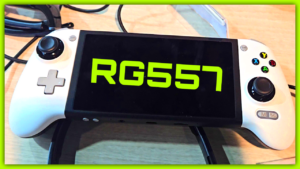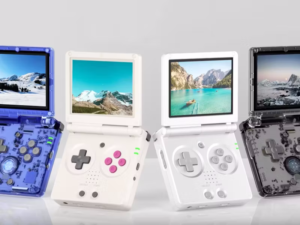What is the Trimui Brick?
The Trimui Brick is the latest handheld device from Trimui, designed to be smaller and more portable than previous models. Unlike the Smart Pro, which was larger and offered a broader range of features, the Brick embraces a compact, vertical format ideal for retro gaming enthusiasts who prefer smaller devices that can easily slip into a pocket.
From a design standpoint, the Trimui Brick bears a striking resemblance to the Miyoo Mini Plus, but with a few modern touches to make it stand out in the crowded retro handheld market. One of the most visually distinct features is the RGB atmosphere lighting on the back of the console, paired with semi-transparent start and select buttons that allow for the glow of unique LED colors to shine through. While this lighting is an aesthetic touch, it could be a point of distraction during gameplay. Hopefully, the brightness can be controlled, though that remains to be seen.
Trimui Brick Specifications
The Trimui Brick may be compact, but it packs enough power to cater to retro gaming needs. Here’s a breakdown of the main specs:
- Display: 3.2-inch IPS display with a 1024 x 768 resolution.
- CPU: Allwinner A133 Plus @ 1.8GHz.
- GPU: Imagination PowerVR GE8300 @ 660MHz.
- RAM: 1GB LPDDR4x.
- Battery: 3000mAh, providing ample battery life for extended gaming sessions.
- Charging: USB-C.
- Connectivity: Wi-Fi, Bluetooth 2.1.
- Audio: 3.5mm headphone jack.
- Weight: 159 grams.
- Extras: Removable backplate and shoulder buttons, RGB lighting, customizable metal backplate option.
From these specifications, it’s clear that Trimui has put thought into making the Brick a capable device, especially for fans of retro consoles. The Allwinner A133 Plus processor, coupled with the PowerVR GE8300 GPU, may not be cutting-edge by today’s standards, but it should comfortably handle retro games up to the PlayStation 1 era. This includes emulating titles from the NES, SNES, Game Boy, and even PS1 libraries, which is a sweet spot for many retro handheld enthusiasts.
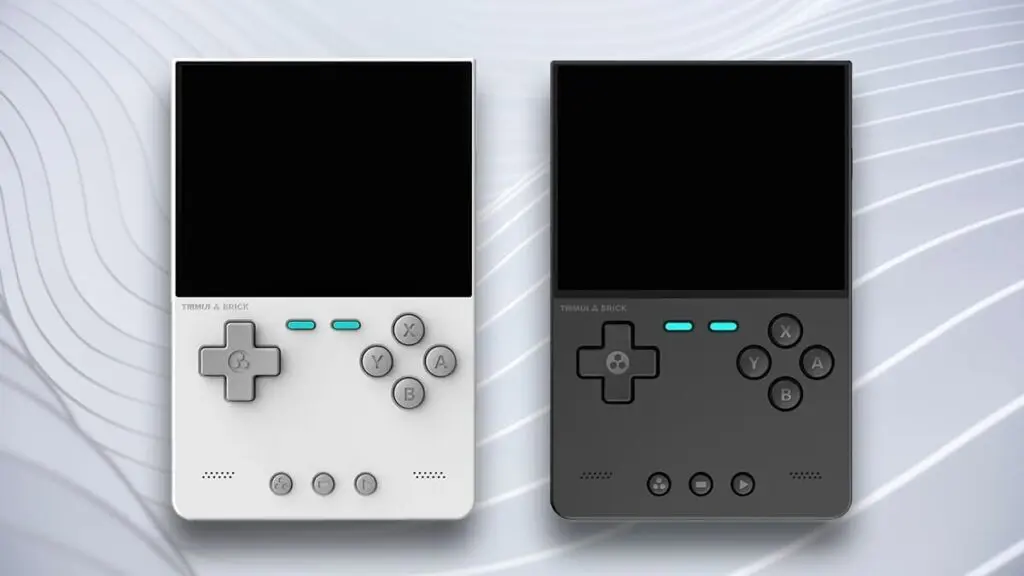
Trimui Brick Design
Design-wise, the Trimui Brick has a certain charm, particularly for those who appreciate retro aesthetics with a modern twist. The overall look of the Brick is reminiscent of the Analogue Pocket, one of the most popular retro handhelds on the market today. The vertical form factor is compact and ergonomic, designed to fit comfortably in your hands while delivering a nostalgic feel, thanks to its Game Boy-style layout.
However, Trimui isn’t just copying the Analogue Pocket—they’ve added their own flair. For one, the back of the device features customizable RGB lighting, a unique feature that distinguishes it from its competitors. While some may see this as a purely cosmetic addition, it offers a level of personalization that might appeal to those who enjoy modding or customizing their gaming consoles.
One of the standout design features is the customizable metal backplate. According to Trimui, users can “customize your console with a CNC metal backplate that can be engraved.” This feature hints at the possibility for users to add personal engravings or unique designs, allowing them to make their Trimui Brick truly one-of-a-kind. While this idea is exciting, it does raise some questions. Is the metal backplate an added accessory or a default feature? Can the plastic backplate be swapped out for the metal one at an extra cost? These details remain unclear, but they certainly open up potential customization options.
The detachable shoulder buttons are another interesting feature, suggesting that users may be able to swap out different styles or colors, further enhancing the customizability of the device. This could pave the way for a secondary market where modders create and sell custom parts for the Trimui Brick, much like we’ve seen with other popular handheld devices in the past.
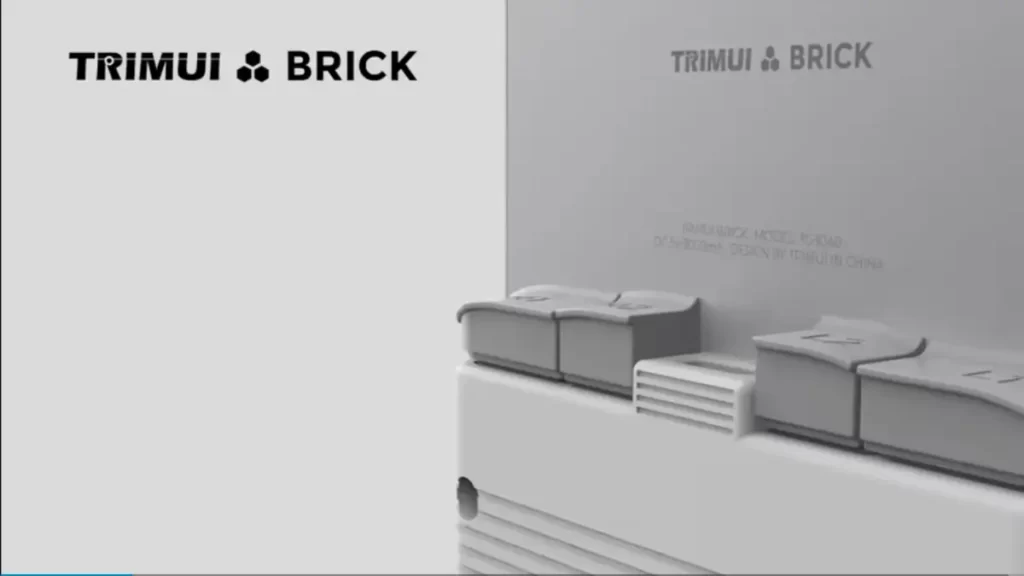
Performance and Game Compatibility
While the Trimui Brick isn’t a powerhouse compared to high-end handhelds, its hardware is more than adequate for retro gaming. The Allwinner A133 Plus processor, combined with the PowerVR GE8300 GPU, should handle emulating games from systems like the NES, SNES, Game Boy, and PlayStation 1 without issue. Although it won’t be capable of running more demanding platforms like the PlayStation 2 or GameCube, it’s perfect for fans of 16-bit and 32-bit games.
One feature that’s worth noting is the Wi-Fi double player battle mode, which could allow gamers to compete with others online in multiplayer games. While details are scarce, the potential for online multiplayer is a welcome addition to any handheld gaming device, particularly in an era where connectivity and social gaming are so integral.
Trimui Brick Display
One of the standout features of the Trimui Brick is its 3.2-inch IPS display with a 1024×768 resolution. The 4:3 aspect ratio is ideal for retro games, which were originally designed for squarer screens, and the resolution ensures that the graphics remain crisp and clear. While the screen size may seem small, the high pixel density ensures that the visuals are sharp, especially when compared to larger, lower-resolution screens on competing devices.
This display resolution, while somewhat unconventional, is similar to older CRT monitors, which gives it an authentic feel when emulating older PC games. If Trimui can optimize the Brick to emulate older PC games, this screen could add a layer of nostalgia for those who remember playing games on 1024×768 CRT monitors.

Is the Trimui Brick Worth the Hype?
While the handheld gaming market is crowded, there’s something refreshing about the Trimui Brick. It offers a nostalgic yet modern design, solid emulation capabilities, and an emphasis on customization that’s rare in today’s gaming landscape.
That said, the Trimui Brick isn’t without its challenges. With a relatively modest processor and GPU, it won’t be able to emulate more demanding consoles like the PlayStation 2 or GameCube. And while the device’s RGB lighting and customization options are fun features, they may not be enough to sway gamers who are looking for more powerful hardware.
Additionally, the market is saturated with compact retro handhelds, and devices like the Miyoo Mini Plus and Powkiddy RGB20 Pro have already carved out a niche. However, the Trimui Brick offers just enough innovation—particularly in its design and customizability—to make it a compelling option for those who prioritize portability and aesthetics over raw power.
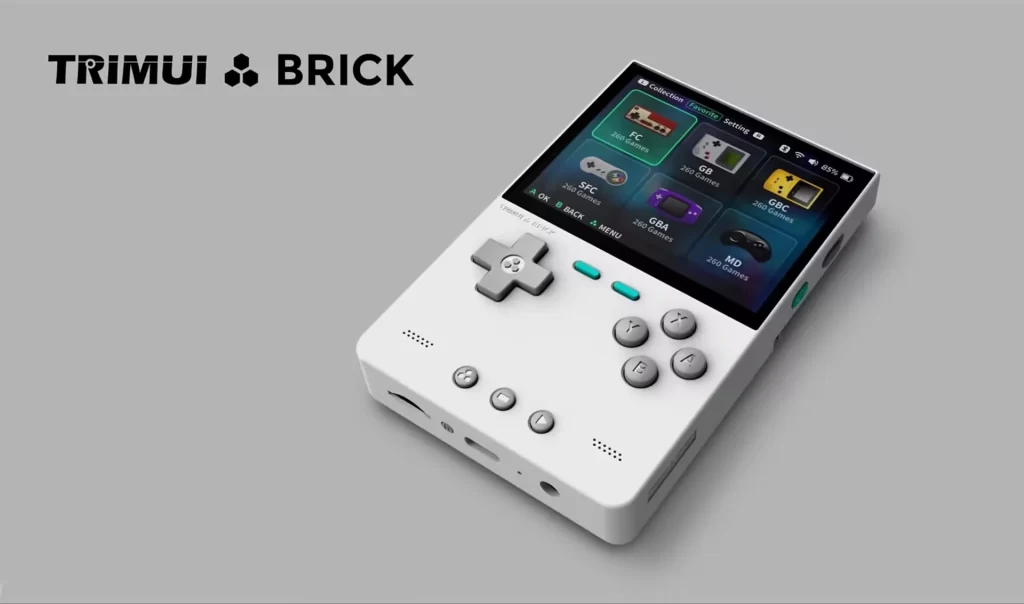
The Verdict
The Trimui Brick represents a thoughtful evolution in the retro handheld market, offering gamers a device that balances portability, performance, and personalization. Whether you’re a collector looking for a unique device to add to your shelf or a retro gaming enthusiast seeking a compact console for on-the-go gaming, the Trimui Brick is a promising contender.
At a weight of just 159 grams, it’s lightweight and comfortable to hold, and with features like customizable RGB lighting and a CNC metal backplate, it offers a level of personalization that’s rare in this space. While it may not offer the raw power of more expensive handhelds, its ability to emulate PS1 and earlier systems, coupled with the potential for multiplayer battles via Wi-Fi, makes it a solid choice for retro gaming enthusiasts.
In conclusion, the Trimui Brick is shaping up to be a unique and exciting addition to the retro gaming handheld market. Its compact design, customizable features, and solid specs make it a standout choice for gamers who value aesthetics and portability. Whether you’re a long time fan of Trimui products or new to the retro gaming scene, the Trimui Brick is worth keeping an eye on.

